
During this miniunit you are going to study characteristics which biologists use to differentiate between those things that are living and those that are nonliving. Before continuing, read over and think about the behavioral objectives 1 and 2. Read pages indicated by (A-1) in your text. What is biology? The study of life. What are living things? What do they all have in common? How do living things differ from non-living things? Let's list some things that all living things, from a bacterium to man, have in common. Some of you may have listed breathing. Do plants breathe? No! Actually you are made up of several small subunits called cells -- these cells themselves do not breathe. Some of you may have listed things such as movement, ability to see, ability to eat. These are not characteristics of living things. Actually there are only a few things which all living things can do. These are listed below.
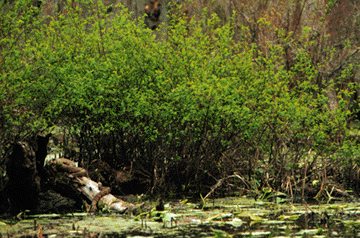
All of the living organisms in the picture above (snakes sunning in Lake Drummond) have the six same characteristics described below. Write these characteristics in your notes. Explain each characteristic and give examples of each.
Organization
The first characteristic of living things is that they are organized
functional patterns, which are not encountered elsewhere. Even the earliest
structural and nonliving things had definite sizes and structures. Therefore,
they can be recognized in ancient microfossils.
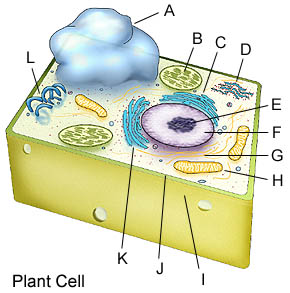
Cells are the structural and functional units of all living matter. Examine the figure above. They are enormously complex, with a nucleus (A) and many smaller structures, or organelles (B-L) each of which has a specific function. Modern plants and animals are made up of millions and even billions of such cells organized into tissues, organs, and systems, each geared to carry out a particular function. Organization is one of the most important properties by which living matter can be identified. Structure in biology is strongly linked to function, and we look at differences in structure to find out how they affect functioning. We do this for the entire organism and for their parts, down to the structures of individual molecules. Organization at the cellular level will be discussed in Miniunit Beta. Write in your notes the levels of organization of living matter beginning with the cell and ending with the biosphere and give examples for each level. See text A-1. All living things on earth contain the elements carbon, hydrogen, oxygen, nitrogen, phosphorus, sulfur and utilize DNA molecules for replication. These will be discussed in miniunit Alpha.
Homeostasis
The second characteristic is closely related to the first. Living systems
maintain a chemical composition quite different from that of their surroundings.
The atoms present in living matter are the same as those in their environment,
but they are present in different proportions and arranged in different
ways. Although living systems constantly exchange certain materials with
their environment, a dynamic process, (any single atom may be present only
briefly in a living structure) these systems maintain their characteristic
chemical composition. This important property is called homeostasis.
It is also defined as dynamic equilibrium. Some examples are: body
temperature in homeotherms, blood sugar (glucose) concentration, chlorophyll
concentration in leaves.

Homeotherms such as humans maintain a body temprature of 98.6 degrees F even if the external temperature is greater.
Energy Utilization
Third, living things have the capacity of taking in energy from their
environment and to transform and use it to make and remake molecules and
to form structures. All organisms carry out reactions that release chemical
energy. The organisms use some of this energy immediately and store the
rest. Metabolism is the sum of all chemical reactions which occur
in an organism. Metabolism can be divided into catabolism and anabolism.
Catabolism is a biochemical process where complex molecules are broken
down into simpler molecules to release energy. An example of catabolism
is cellular respiration. In miniunit Epsilon two types of cellular
respiration will be investigated, aerobic and anaerobic. During aerobic
respiration oxygen gas will be utilized and anaerobic respiration can occur
in the absence of oxygen gas. Heterotrophs are those organisms which
take energy rich molecules from the environment, metabolize these substances
to release energy and to make chemical building blocks from which other
substances may be made. Anabolism is a biochemical process where complex
molecules are synthesized from simpler molecules; therefore, this process
requires energy. An example of anabolism is photosynthesis. Autotrophs
are those organisms which obtain their energy from light to synthesize
energy rich molecules which they will use directly or store for future
use. Heterotrophs receive their energy directly or indirectly from the
autotrophs. Look up catabolism and anabolism in the glossary of your text.
Organisms transform chemical energy to kinetic energy, the energy of motion.
Some use it to send electrical signals, and some even convert it to light
energy and glow in the dark! You will discover how living organisms utilize
energy from molecules in the environment in Miniunit Epsilon. Write
the definitions of the terms in bold in your notes. All cellular organisms
carry out the process of cellular respiration and only a few in addition
to respiration carry out the process of photosynthesis.
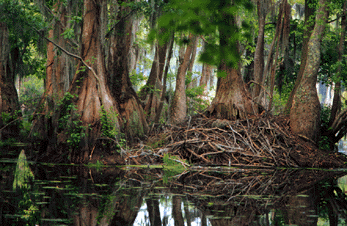
This picture depicts an ecosystem in the Great Dismal Swamp with a beaver home in the background. Which organisms in this picture are the autrophs? heterotophs? Are any of the structures in this picture not made up of living organisms?
Irritability
Fourth, living systems can respond to stimuli. Bacteria move
toward or away from particular chemicals; green plants bend toward light;
meal worms congregate where it is damp; cats pounce on small moving objects.
These phenomena are manifestations of a property generally known as irritability.
Although different organisms respond to widely varying stimuli, and although
the complexity of the response varies greatly, the capacity to respond
is a fundamental and universal characteristic of life.
Reproduction
Fifth, and most remarkably, living things have the capacity to reproduce
themselves with astonishing fidelity (and yet, as we shall see, with just
enough variation to provide the material on which evolution depends). Reproduction
may be divided in the following manner. Cellular reproduction is
where one cell reproduces another. This is an asexual type of reproduction
and it occurs during the growth of an organism, repair of damaged cells
of an organism, and formation of a new organism by asexual reproduction
such as unicellular (amoeba, bacteria) reproduction or forming multicellular
organisms by asexual means (budding in hydra, plant cuttings). Sexual
reproduction is where genetic material from two organisms combine and
forms an individual with genetic material of both parents. This reproductive
process has been going on now for more than three billion years. All organisms
today can trace their ancestry back to the first, primitive cells. When
organisms reproduce the offspring are not exact copies of themselves. The
difference between parents and offspring may be transmitted to the next
generation along with more changes. This property of reproducing offspring
with changes is responsible for the evolution of living organisms
through adaptations. You will examine these processes in Miniunit Gamma
and Delta.
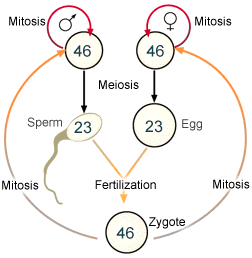
The figure above depicts the human life cycle in humans showing the continuity of chromosomes. The numbers 23 and 46 represent the number of chromosomes is a cell.
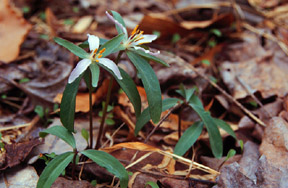
Higher plants have flowers which are used for sexual reproduction.
Adaptation
Finally, among living things, some are selected as time passes because
they are adapted to cope with their environment. This is called descent
with modification. An individual giraffe does not grow its neck longer
in order to reach the high branches, nor does a flower emit a sweet odor
in order to attract bees, nor does a pancreas cell secrete insulin in order
to take sugar from the blood. Yet giraffes do have long necks, flowers
do emit sweet scents, and the pancreatic secretion does permit body cells
to take sugar from the blood. They do these particular things because,
in the course of evolution, these activities and the structures that make
them possible have proved to be of survival value for the individual and
the species. This process is called natural selection. And the individual
so endowed have therefore persisted. As a consequence, it is appropriate
to ask questions about the function of any structure or activity of any
living thing in terms of its usefulness: How does it equip the organism
for life in a particular environment? We can appropriately ask the same
question about the most microscopic structure. Adaptation is uniquely
a biological phenomena. Living organisms come in many shapes, sizes and
colors. Study the table in the text listing the kingdoms with examples.
See reading list A-1. Examine
the pictures and read the captions from pages indicated by A-2). We
will study the Diversity of Life later in the semester.
Living organisms are often grouped into five major categories, called kingdoms.
1. Which of the following is not considered a kingdom?
- a) Plantae
- b) Monera
- c) Protista
- d) Vertebrate
- e) Fungi
2. Plants when placed in an unilateral light (light from one direction) will tend to bend towards the light. Which characteristic of life does this demonstrate?
- a) asexual reproduction
- b) irritability
- c) homeostasis
- d) adaptation
- e) organization
3. Which organisms would form a larger number of diverse members in their population?
- a) Organisms which only reproduce asexually.
- b) Organisms which reproduce sexually.
- c) Both "a" and "b"
Now that you know the characteristics of living organisms, let us examine the chemical composition of living organisms Before you can learn about the macromolecules which make up living organisms, we must learn some basic chemical terminology . Before you start, read the pages indicated by (A-3) to give you some background on the subject matter.
This the end of lesson one,
Click here to go back to the Miniunit Alpha Lessons.Lesson two, Atomic Structure.
For information on how to use this page, go to How
to Use This Site.
Created by the Center for Learning Technologies, Academic Technology Services.
Last modified October 22, 1997.